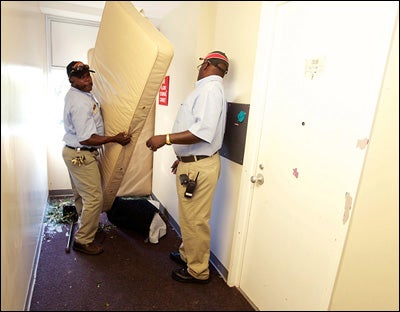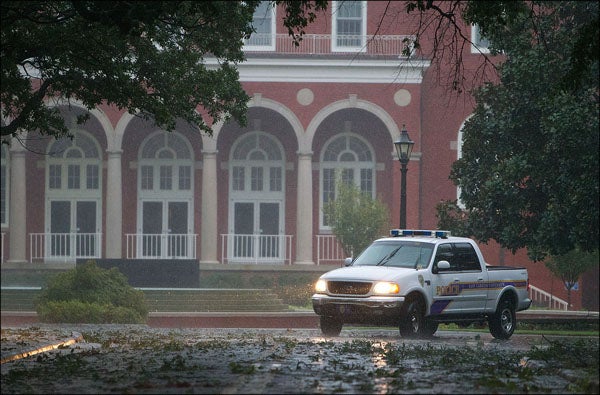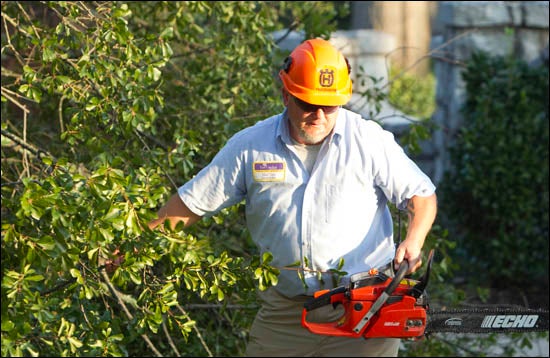GOODBYE, IRENE: ‘Everyone pulled together’
As Hurricane Irene raged across Greenville, the phones in the East Carolina University Police Department were busy. Really busy.
“We were getting all kinds of calls,” said Maj. Frank Knight. “One student called saying they were being held inside their rooms and weren’t being fed. We told them to talk to their resident adviser. And then the rumor went around that the roof had been blown off a residence hall.”
He then laughed and said, “And we took calls from students living off campus who had lost power and were calling to see if we could find them a room on campus in one of the dorms.”
Recovery from Irene moved quickly on ECU’s campus. Even with 170 downed trees and an estimated $1.7 million in damage, classes resumed Wednesday. That took non-stop work and personal sacrifice from many staff on campus whose roles keep them mostly behind the scene: police, building and grounds, facilities and housekeeping.

Franklin Andrews and Henry Henderson, ECU Facilities Services, remove mattresses and tables used to block a broken window in Greene residence hall.
The residence halls were full with an estimated 3,000 students over the weekend; ECU’s 15 residence halls are housing 5,034 students this semester, according Aaron Lucier with Campus Living/Housing.
Knight said Dispatcher Dawn Arnold got the job of handling the calls coming in during the storm, along with three other dispatchers. The calls ranged from worried parents to students reporting damage on campus.
During the height of the storm, Knight said ECU Police had officers “sheltered in place” across the campus. “After things calmed down around 10 or 11 p.m., we started going around doing the preliminary assessment,” he said. He credited Lt. Curtis Hayes and Lt. D.J. Gregory with running the Emergency Operations Center and Lt. Amy Davis and Lt. Chris Sutton for their direct supervision of the officers out in the storm.
Picking up the pieces
Hurricane Irene left downed trees, broken residence hall windows, battered roofs and damp quarters in many buildings at ECU. The damage has kept staff busy with mops, hammers, nails, chain saws, Bobcats and tractors.
The job of removing the downed trees went to the university’s Facilities Services department.
As the storm continued to blow Aug. 28, Matt Vayo with ECU Facilities Services – Grounds Services received a phone call from his supervisor Ron Newton asking him to report to campus at 7 a.m. Sunday.
“I knew the situation must be bad,” Vayo said. He was not prepared for what he saw. “I was shocked at the number of trees and debris that littered the grounds. It looked like a tornado had come through campus.”
Wielding a chain saw, Vayo and three other crew members began removing debris around the mall area between the Spilman and the School of Art buildings where three oaks had fallen. The largest of the 100-year-old trees rested on an electrical switch box. “It’s always sad to lose one of those (trees),” he said. “They’ve been here a long time.
Pockets of ground crews echoed similar cleanup scenarios throughout the day Sunday. Heavy equipment traversed the campus and chain saws buzzed.
“Everyone worked well together,” Vayo said. “Grounds crew members who typically don’t work with each other joined forces to get the job done and bring order back to our campus.”
Spilman damage urgent
Some of the worst damage was in Spilman, an administration building built in the 1920s that houses the chancellor’s office. Irene snatched metal sheeting off the roof and rain soaked ceilings and walls inside, including in the chancellor’s conference room.
In Greene Residence Hall, wind pried at the roof enough to break a storm drainpipe underneath and send water into the building. About two dozen students were moved to the lobby during the storm. Five students from three rooms in Greene have been relocated to another residence hall for a few weeks while permanent repairs are made.
Campus Living’s Lucier praised the residence hall staff – both student and professional – who worked to make sure the residents stayed safe during the storm. “It is not easy to have a day like Saturday. Some of the hall staff had water and other issues in their staff apartments while addressing student concerns,” he said.
He noted Veronica Rodriguez Rivera, a residence hall coordinator who just started at ECU this summer, had to deal with the challenges of the broken roof drain in Greene, which caused hundreds of gallons of water to enter the building. Her apartment took some damage and she had to temporarily move to a spare apartment, he said.
Across campus, Holly Bowen, another residence hall coordinator who has been with ECU for a year, was facing her own challenge at College Hill Suites: No power for a longer period of time than the other halls. That caused issues with the plumbing and no air conditioning for most of Saturday.
A wet mess
Back at Spilman work on the more than 90-year-old building began on Sunday as well.
Carpenter Jay Wainwright left his 4-month-old son and wife at home to come into campus and help out in the damaged building.
“It was the biggest mess I’ve ever seen,” said Wainwright. He said the guys working the night before had done the best they could, but “everything was soaking wet. There were ceiling tiles on the floor. Sheetrock had gotten wet and fallen on the floor. It was just a mess.”

Jay Wainwright of ECU Facilities Services works to remove water captured from leaks in Spilman.
Born and raised in Greenville, Wainwright has seen a few hurricanes come through, including Hurricane Floyd. Although the water damage from Floyd was extensive, he said, he had never seen wind damage so bad on campus.
Wainwright had little damage at home, just some shingles off the roof. Leaving his wife and infant son was not easy, but he wanted to help out on campus as well. Power came back at home about 1 a.m. on Sunday, which made it easier to leave for work, he said.
Also working in Spilman was Henry Henderson, Facilities Services -Carpentry. He arrived on campus Sunday morning about 7:30 a.m., after a difficult trip navigating around downed trees and flooded roadways from his home north of the Pitt Greenville airport. In Spilman, he worked removing wet ceiling tiles, wrapping up wet furniture and checking the building for additional damage. Taking out the ceiling tiles quickly was critical, he said, because they will begin to mold within 24 hours.
‘Everyone pulled together’
Henderson left a wife, daughter and grandson at home to come to work at ECU, waiting until after his shift on campus to inspect his own home’s damage. At home he found some trees down, a fence ripped apart and a few shingles, but nothing like the damage he experienced after Hurricane Floyd.
In the flooding that followed Floyd, Henderson lost everything to about 2 or 3 feet of water in his house. After something like that, he said, “every time a storm happens, it makes you think. We had bags packed and ready in case we had to leave in a hurry.”
But this storm was more about wind than water, he said, with lots of trees coming down in his neighborhood. The scene was similar at ECU, where he saw “a whole lot of downed trees and standing water.”
Henderson was especially proud of the way the entire ECU maintenance department pulled together to get the campus back to normal.
“Everyone really pulled together and worked hand in hand, like one big unit, to get done what needed to be done. I felt really good about that,” he said.

ECU Police patrol during Hurricane Irene.
